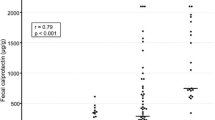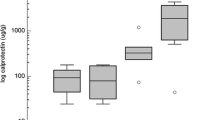Abstract
Ulcerative colitis (UC) is a chronic, idiopathic, inflammatory large bowel disease with recurrent variable periods of exacerbation. The aim of the current study is to evaluate the correlation of UCEIS with fecal calprotectin (FC) level to assess disease activity in UC patients in order to determine whether FC can prognosticate clinical outcome and disease activity of UC instead of colonoscopic evaluation. Our endoscopic investigations revealed the extension of UC as the following: proctitis (11.6 %), procto-sigmoiditis (18.5 %), left-sided colitis (15.8 %), extensive colitis (11.7 %), and normal endoscopy (42.4 %). Conclusively, we suggest that FC can be used as a reliable tool to evaluate disease activity in ulcerative colitis patients. Moreover, our findings indicate a significant correlation between FC level and mucosal healing.

Similar content being viewed by others
References
Langhorst J, Elsenbruch S, Mueller T et al (2005) Comparison of 4 neutrophil-derived proteins in feces as indicators of disease activity in ulcerative colitis. Inflamm Bowel Dis 11(12):1085–1091
Fefferman DS, Farrell RJ (2005) Endoscopy in inflammatory bowel disease: indications, surveillance, and use in clinical practice. Clin Gastroenterol Hepatol: the official clinical practice journal of the American Gastroenterological Association. 3(1):11–24
Schoepfer AM, Beglinger C, Straumann A et al (2009) Ulcerative colitis: correlation of the Rachmilewitz endoscopic activity index with fecal calprotectin, clinical activity, C-reactive protein, and blood leukocytes. Inflamm Bowel Dis 15(12):1851–1858
Angriman I, Scarpa M, D’Inca R et al (2007) Enzymes in feces: useful markers of chronic inflammatory bowel disease. Clin Chim Acta; International Journal Of Clinical Chemistry. 381(1):63–68
Travis SP, Schnell D, Krzeski P et al (2013) Reliability and initial validation of the ulcerative colitis endoscopic index of severity. Gastroenterology 145(5):987–995
Walsh AJ, Ghosh A, Brain AO et al (2014) Comparing disease activity indices in ulcerative colitis. J Crohns Colitis 8(4):318–325
Carpenter HA, Talley NJ (2000) The importance of clinicopathological correlation in the diagnosis of inflammatory conditions of the colon: histological patterns with clinical implications. Am J Gastroenterol 95(4):878–896
Nikolaus S, Schreiber S (2007) Diagnostics of inflammatory bowel disease. Gastroenterology 133(5):1670–1689
Vermeire S, Van Assche G, Rutgeerts P (2006) Laboratory markers in IBD: useful, magic, or unnecessary toys? Gut 55(3):426–431
Desai D, Faubion WA, Sandborn WJ (2007) Review article: biological activity markers in inflammatory bowel disease. Aliment Pharmacol Ther 25(3):247–255
Gisbert JP, Gonzalez-Lama Y, Mate J (2007) Role of biological markers in inflammatory bowel disease. Gastroenterol Hepatol 30(3):117–129
Tibble JA, Sigthorsson G, Bridger S et al (2000) Surrogate markers of intestinal inflammation are predictive of relapse in patients with inflammatory bowel disease. Gastroenterology 119(1):15–22
Tibble JA, Bjarnason I (2001) Non-invasive investigation of inflammatory bowel disease. World J Gastroenterol 7(4):460–465
Bitton A, Peppercorn MA, Antonioli DA et al (2001) Clinical, biological, and histologic parameters as predictors of relapse in ulcerative colitis. Gastroenterology 120(1):13–20
Sutherland AD, Gearry RB, Frizelle FA (2008) Review of fecal biomarkers in inflammatory bowel disease. Dis Colon Rectum 51(8):1283–1291
Geboes K, Riddell R, Ost A et al (2000) A reproducible grading scale for histological assessment of inflammation in ulcerative colitis. Gut 47(3):404–409
Bjerke K, Halstensen TS, Jahnsen F et al (1993) Distribution of macrophages and granulocytes expressing L1 protein (calprotectin) in human Peyer’s patches compared with normal ileal lamina propria and mesenteric lymph nodes. Gut 34(10):1357–1363
Costa F, Mumolo MG, Ceccarelli L et al (2005) Calprotectin is a stronger predictive marker of relapse in ulcerative colitis than in Crohn’s disease. Gut 54(3):364–368
Johne B, Fagerhol MK, Lyberg T et al (1997) Functional and clinical aspects of the myelomonocyte protein calprotectin. Mol Pathol 50(3):113–123
Konikoff MR, Denson LA (2006) Role of fecal calprotectin as a biomarker of intestinal inflammation in inflammatory bowel disease. Inflamm Bowel Dis 12(6):524–534
Xiang JY, Ouyang Q, Li GD et al (2008) Clinical value of fecal calprotectin in determining disease activity of ulcerative colitis. World J Gastroenterol 14(1):53–57
Langhorst J, Elsenbruch S, Koelzer J et al (2008) Noninvasive markers in the assessment of intestinal inflammation in inflammatory bowel diseases: performance of fecal lactoferrin, calprotectin, and PMN-elastase, CRP, and clinical indices. Am J Gastroenterol 103(1):162–169
Canani RB, Terrin G, Rapacciuolo L et al (2008) Faecal calprotectin as reliable non-invasive marker to assess the severity of mucosal inflammation in children with inflammatory bowel disease. Dig Liver Dis : official journal of the Italian Society of Gastroenterology and the Italian Association for the Study of the Liver. 40(7):547–553
Silberer H, Kuppers B, Mickisch O et al (2005) Fecal leukocyte proteins in inflammatory bowel disease and irritable bowel syndrome. Clin Lab 51(3–4):117–126
Gisbert JP, McNicholl AG (2009) Questions and answers on the role of faecal calprotectin as a biological marker in inflammatory bowel disease. Dig Liver Dis: official journal of the Italian Society of Gastroenterology and the Italian Association for the Study of the Liver. 41(1):56–66
Garcia-Sanchez V, Iglesias-Flores E, Gonzalez R et al (2010) Does fecal calprotectin predict relapse in patients with Crohn’s disease and ulcerative colitis? J Crohns Colitis 4(2):144–152
D’Haens G, Sandborn WJ, Feagan BG et al (2007) A review of activity indices and efficacy end points for clinical trials of medical therapy in adults with ulcerative colitis. Gastroenterology 132(2):763–786
Naganuma M, Ichikawa H, Inoue N et al (2010) Novel endoscopic activity index is useful for choosing treatment in severe active ulcerative colitis patients. J Gastroenterol 45(9):936–943
Travis SP, Schnell D, Krzeski P et al (2012) Developing an instrument to assess the endoscopic severity of ulcerative colitis: the Ulcerative Colitis Endoscopic Index of Severity (UCEIS). Gut 61(4):535–542
Rachmilewitz D (1989) Coated mesalazine (5-aminosalicylic acid) versus sulphasalazine in the treatment of active ulcerative colitis: a randomised trial. BMJ 298(6666):82–86
Cooney RM, Warren BF, Altman DG et al (2007) Outcome measurement in clinical trials for Ulcerative Colitis: towards standardisation. Trials 8:17
Gisbert JP, Bermejo F, Perez-Calle JL et al (2009) Fecal calprotectin and lactoferrin for the prediction of inflammatory bowel disease relapse. Inflamm Bowel Dis 15(8):1190–1198
Kaiser T, Langhorst J, Wittkowski H et al (2007) Faecal S100A12 as a non-invasive marker distinguishing inflammatory bowel disease from irritable bowel syndrome. Gut 56(12):1706–1713
Conflict of interest
None.
Author information
Authors and Affiliations
Corresponding author
Rights and permissions
About this article
Cite this article
Taghvaei, T., Maleki, I., Nagshvar, F. et al. Fecal calprotectin and ulcerative colitis endoscopic activity index as indicators of mucosal healing in ulcerative colitis. Intern Emerg Med 10, 321–328 (2015). https://doi.org/10.1007/s11739-014-1144-x
Received:
Accepted:
Published:
Issue Date:
DOI: https://doi.org/10.1007/s11739-014-1144-x




